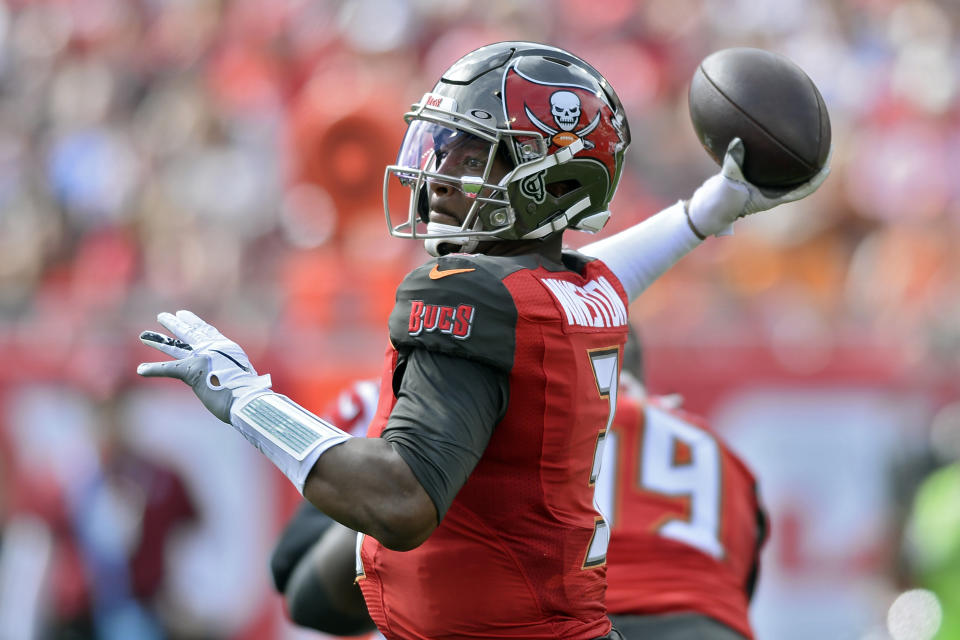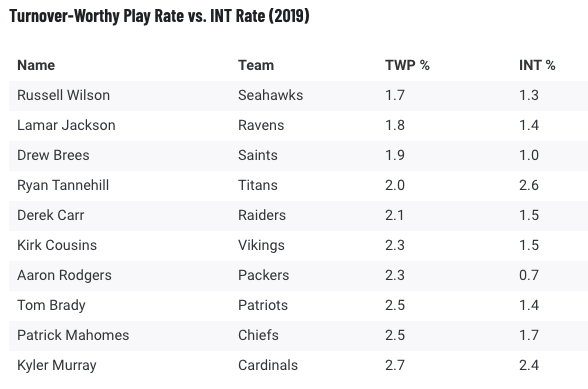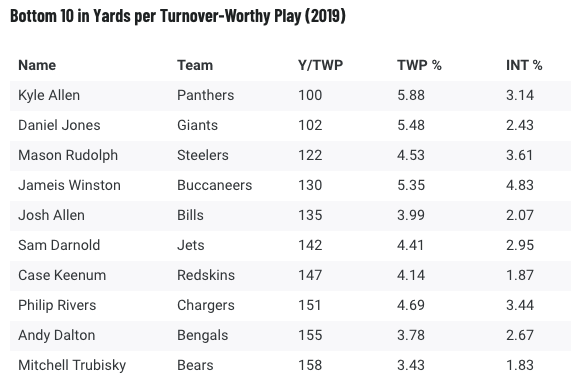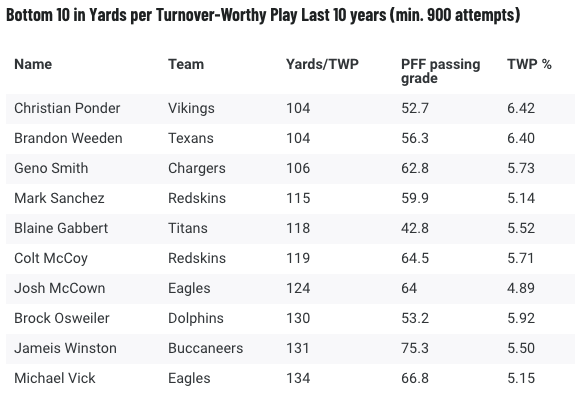Can Jameis Winston be a productive QB despite the multitude of INTs?
By Sam Monson
Analyzing quarterback play is a tricky balance between production and putting the ball in harm’s way. The best quarterbacks move the ball consistently without making many mistakes. The worst struggle to move it at all, while making mistakes regularly. Most players live somewhere in the middle. The balance between those two areas is critical.
In the past, people have looked at the mistakes using interception rate, but that’s a statistic vulnerable to factors outside of a quarterback’s influence. A QB can throw a perfect pass that hits his receiver’s hands, only to see it bounce up into the sky and be picked off. That QB can also make a terrible read and throw the ball straight to a linebacker only to see the defender drop the interception, recording merely an incompletion.
PFF’s grading system allows us to quantify these instances where the stat sheet misleads and tell a far more accurate picture using Turnover-Worthy Plays. These are the lowest-graded throws in PFF’s grading scale and capture bad plays whether or not they resulted in a turnover. The designation can also absolve a quarterback for plays that were not his fault, such as dropped passes and plays where the receiver hung him out to dry by stopping his route, running a bad route or ending up on a different page entirely.
Our review process uses All-22 tape, NFL feedback and former NFL quarterbacks in the grading process, which allows us to apply our grades with degrees of context that aren’t present in other raw data sets.


Broadly speaking, turnover-worthy play rate will be a higher number, as defenders drop a lot of interceptions. Using TWP rate, we can paint a picture of which quarterbacks put the ball in harm’s way the most or the least. Over the past decade, Tom Brady has the best TWP rate in the game, while the players with the worst is a who’s who of lousy quarterbacks.
How productive is a quarterback on average between mistakes?
Are there quarterbacks who are prone to mistakes but productive enough in between them that it offsets the negatives (Jameis Winston, I’m looking your way with Lasik-enhanced eyesight)?
The short answer to this is, essentially, no. At least not over extended time.
Over the past decade, no quarterback has been able to override a high turnover-worthy play rate with offensive production. Winston leads the NFL in the percentage of his plays that earn a positive PFF grade since entering the league, but even Winston can generate only another 25 passing yards or so between mistakes than the worst quarterbacks in the league. He makes that many errors.

Even in 2019, the most Jameis of Jameis seasons, almost 5,200 passing yards couldn’t put a dent in the 40 TWPs he posted. Only Mason Rudolph, Daniel Jones and Kyle Allen generated less passing production per TWP than Winston.
This data backs up the league’s opinion on Winston that for all the good he does, his predilection for turning the ball over is too strong and too entrenched to live with. If Winston wants to revive his career as a long-term starter, the single biggest thing he can do to move that needle is dial back on the mistakes, even if it means taking some of the production off the top.
Though we are working with far more limited data, these numbers also highlight how far Daniel Jones still needs to go to be a quality NFL quarterback. His high-end stuff was excellent as a rookie. If that’s all you were judging him on, you would already be sold on his pedigree and believe the New York Giants were correct in drafting him that high. His TWP rate was catastrophic, and he averaged just a hair over 100 yards per TWP, or around 25 percent of Ryan Tannehill’s production.
The upside that Jones showed as a rookie was encouraging, but his viability will be determined by whether he can cut down on his mistakes. If he can’t, he is set to repeat Winston’s career arc — unable to be productive enough to offset the turnovers or turnover-worthy mistakes.

Players who show high volatility often get more rope than game managers because coaches believe they can affect the negatives. It’s also because when they’re right, they immediately catapult that player into being one of the better quarterbacks in football.
If you halved the number of TWPs from Winston last season, he would have averaged 259 yards between them, which would put him behind Patrick Mahomes and ahead of Aaron Rodgers in terms of production per mistake. That optimism, or hubris, from coaches might be misplaced, but the outcome may back them up from time to time.
The other factor at play in changing those low-end plays is pure dumb luck. Each of those TWPs can bounce the other way on any given play, making a would-be interception an incompletion.
Occasionally, these highly volatile quarterbacks can experience a lucky run where the TWPs don’t cost them anything, but they still benefit from all of the positive production. When that happens, marginal starters become Pro Bowlers. It could be worth sticking with those passers and trying to catch the wave of positive variance, because if they do experience that, a team’s quarterback situation suddenly papers over any multitude of other cracks.
The bottom line is that any quarterback with a disastrous level of turnover-worthy play rate needs to change that quickly to have long-term success in the league because no amount of high-end throws or down-to-down production can offset a crippling error rate.
For more analytical analysis of the NFL, go to PFF.com.
More from Yahoo Sports:

